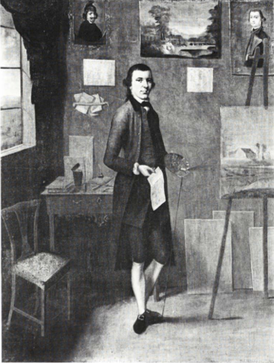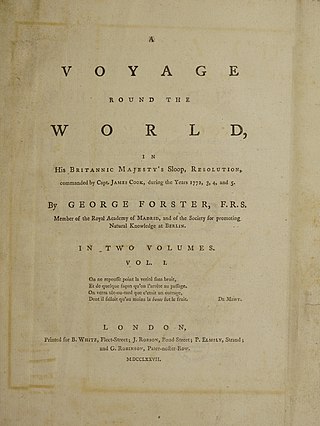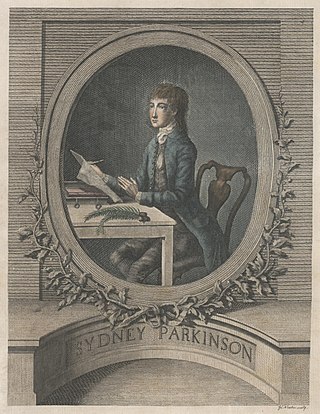
Captain James Cook was a British explorer, cartographer and naval officer famous for his three voyages between 1768 and 1779 in the Pacific Ocean and to New Zealand and Australia in particular. He made detailed maps of Newfoundland prior to making three voyages to the Pacific, during which he achieved the first recorded European contact with the eastern coastline of Australia and the Hawaiian Islands, and the first recorded circumnavigation of New Zealand.

The Lewis and Clark Expedition, also known as the Corps of Discovery Expedition, was the United States expedition to cross the newly acquired western portion of the country after the Louisiana Purchase. The Corps of Discovery was a select group of U.S. Army and civilian volunteers under the command of Captain Meriwether Lewis and his close friend Second Lieutenant William Clark. Clark and 30 members set out from Camp Dubois, Illinois, on May 14, 1804, met Lewis and ten other members of the group in St. Charles, Missouri, then went up the Missouri River. The expedition crossed the Continental Divide of the Americas near the Lemhi Pass, eventually coming to the Columbia River, and the Pacific Ocean in 1805. The return voyage began on March 23, 1806, at Fort Clatsop, Oregon, and ended on September 23 of the same year.

The Rosetta Stone is a stele of granodiorite inscribed with three versions of a decree issued in Memphis, Egypt, in 196 BC during the Ptolemaic dynasty on behalf of King Ptolemy V Epiphanes. The top and middle texts are in Ancient Egyptian using hieroglyphic and Demotic scripts, respectively, while the bottom is in Ancient Greek. The decree has only minor differences between the three versions, making the Rosetta Stone key to deciphering the Egyptian scripts.

Joseph Banks, 1st Baronet, was an English naturalist, botanist, and patron of the natural sciences.
John Cawte Beaglehole was a New Zealand historian whose greatest scholastic achievement was the editing of James Cook's three journals of exploration, together with the writing of an acclaimed biography of Cook, published posthumously. He had a lifelong association with Victoria University College, which became Victoria University of Wellington, and after his death it named the archival collections after him.
A warrior is a person specializing in combat or warfare, especially within the context of a tribal or clan-based warrior culture society that recognizes a separate warrior aristocracy, class, or caste.

Lionel Mordecai Trilling was an American literary critic, short story writer, essayist, and teacher. He was one of the leading U.S. critics of the 20th century who analyzed the contemporary cultural, social, and political implications of literature. With his wife Diana Trilling, whom he married in 1929, he was a member of the New York Intellectuals and contributor to the Partisan Review.
The history of Hawaii describes the era of human settlements in the Hawaiian Islands. The islands were first settled by Polynesians sometime between 1000 and 1200 AD forming the modern population of Native Hawaiians. Hawaiian civilization was isolated from the rest of the world for at least 500 years.

The Guugu Yimithirr, also spelt Gugu Yimithirr and also known as Kokoimudji, are an Aboriginal Australian people of Far North Queensland, many of whom today live at Hopevale, which is the administrative centre of Hopevale Shire. At the 2011 census, Hopevale had a population of 1,005 people. It is about 46 kilometres (29 mi) from Cooktown by road. It is also the name of their language. They were both a coastal and inland people, the former clans referring to themselves as a "saltwater people".

Sydney Parkinson was a Scottish botanical illustrator and natural history artist. He was the first European artist to visit Australia, New Zealand and Tahiti. Parkinson was the first Quaker to visit New Zealand. The standard author abbreviation Parkinson is used to indicate this person as the author when citing a botanical name.

Mary Randolph was a Southern American cook and author, known for writing The Virginia House-Wife; Or, Methodical Cook (1824), one of the most influential housekeeping and cook books of the 19th century. Many of the recipes used local Virginia ingredients including Tanacetum vulgare virginia pudding, pickled nasturtiums and desserts with the native gooseberry. She was the first person known to be buried at what would become known as Arlington National Cemetery.

Alexander Buchan was a Scottish landscape artist. He is known for his participation in the 1768–1771 first voyage of James Cook aboard HMS Endeavour, where he was one of the artists in the entourage of botanist Joseph Banks. Buchan had epilepsy. On the journey, he had two documented seizures, the first during an expedition in Tierra del Fuego. Buchan died after the second seizure, shortly after Endeavour's arrival at Tahiti, and was buried at sea. Buchan produced landscapes, coastal views, ethnographic drawings and natural history drawings. He is best known for illustrations of the people of Tierra del Fuego, some of which were engraved for publication in accounts of the voyage. All of his drawings from the voyage were taken by his employer Joseph Banks and are now in the British Library and the Natural History Museum, London.
Kānekapōlei was a Native Hawaiian aliʻi wahine (queen) and wife of Kalaniʻōpuʻu, aliʻi nui of the Island of Hawaii and aunt of Kamehameha I, who were all present at Captain James Cook's death. She called attention to the kidnapping of her husband by Cook and his men, attracting his royal attendants to the beach, answering her calls for help.

Kalaimanokahoʻowaha was an aliʻi high chief of the island of Hawaii who lived during the period of Captain James Cook's visit to the islands. He was the chief said to have struck the first blow to Cook when he attempted to kidnap Kalaniʻōpuʻu, the king of the island. He was called Kanaʻina nui as a birthright from his father, Keaweʻopala, first born son of Alapainui. After his father was killed by Kalaniʻōpuʻu, he would serve the new king as a kaukau aliʻi, a service class of Hawaiian nobility that his mother, Moana Wahine had descended from. This aliʻi service line would continue throughout the Kingdom of Hawaii.

On 14 February 1779, English explorer Captain James Cook attempted to kidnap Kalaniʻōpuʻu, the ruling chief of the island of Hawaii. The decision to hold him in exchange for a stolen longboat was the fatal error of Cook's final voyage, and led to his death at Kealakekua Bay.

The Tahitian Dog is an extinct breed of dog from Tahiti and the Society Islands. Similar to other strains of Polynesian dogs, it was introduced to the Society Islands and Tahiti by the ancestors of the Tahitian (Mā’ohi) people during their migrations to Polynesia.

A Voyage Round the World is Georg Forster's report on the second voyage of the British explorer James Cook. During the preparations for Cook's voyage, the expedition's naturalist Joseph Banks had withdrawn his participation, and Georg's father, Johann Reinhold Forster, had taken his place at very short notice, with his seventeen-year-old son as his assistant. They sailed on HMS Resolution with Cook, accompanied by HMS Adventure under Tobias Furneaux. On the voyage, they circumnavigated the world, crossed the Antarctic Circle and sailed as far south as 71° 10′, discovered several Pacific islands, encountered diverse cultures and described many species of plants and animals.

Observations Made During a Voyage Round the World is Johann Reinhold Forster's systematic account of the scientific and ethnological results of the second voyage of James Cook. Forster, a former pastor who had become a Fellow of the Royal Society after writing several papers on natural history, and his son Georg had accompanied James Cook as naturalists on board of HMS Resolution. Originally, it had been planned that Forster's account should appear together with Cook's "narrative" of the voyage, but after lengthy arguments between Forster and John Montagu, 4th Earl of Sandwich, the First Lord of the Admiralty, Georg went ahead and published his own narrative instead in 1777, A Voyage Round the World. Observations then appeared in 1778, financed by subscriptions. It was translated into several European languages, including a German translation by Georg Forster.

A Journal of a Voyage to the South Seas, in His Majesty's ship, the Endeavour is a 1773 book based on the papers of Sydney Parkinson, who accompanied Joseph Banks as botanical illustrator on the first voyage of James Cook. Parkinson died at sea in 1771 on the return voyage, and the Journal was compiled by William Kenrick for Parkinson's brother Stanfield, who quarrelled with Banks about his brother's papers and belongings and attacked Banks and others in the book's preface. A legal injunction prevented the publication of the Journal until after the official account of Cook's voyage, edited by John Hawkesworth, had appeared. A second edition appeared in 1784 with explanatory remarks by John Fothergill.

An Account of the Voyages Undertaken by the Order of his Present Majesty for Making Discoveries in the Southern Hemisphere, and successively performed by Commodore Byron, Captain Wallis, Captain Carteret, and Captain Cook, in the Dolphin, the Swallow, and the Endeavour: drawn up from the journals which were kept by the several commanders, and from the papers of Joseph Banks, Esq. is a 1773 book by John Hawkesworth about several Royal Navy voyages to the Pacific: the 1764–1766 and 1766–1768 voyages of HMS Dolphin under John Byron and Samuel Wallis, the voyage of HMS Swallow under Philip Carteret (1766–1769), as well as the 1768–1771 first voyage of James Cook on HMS Endeavour. Hawkesworth received an advance of £6,000 for editing the three volumes.
















